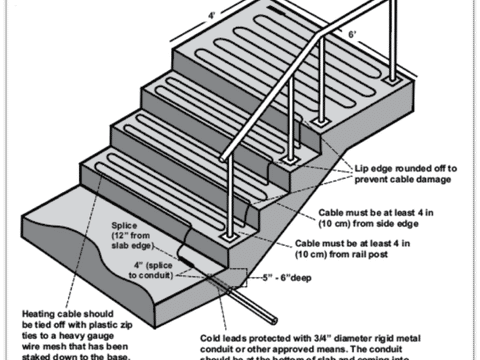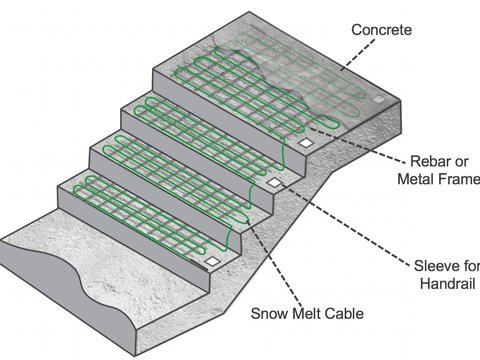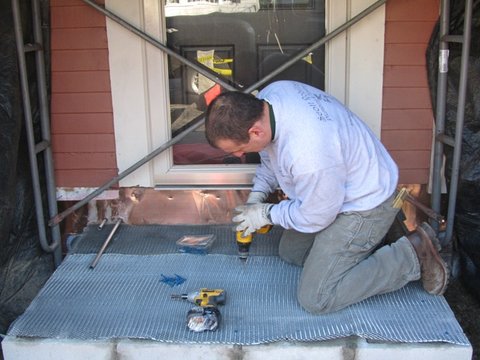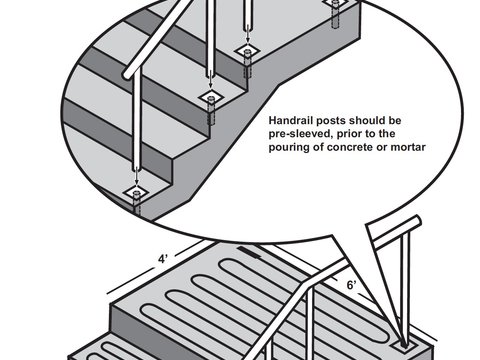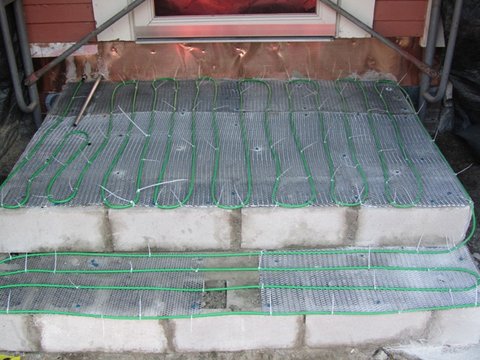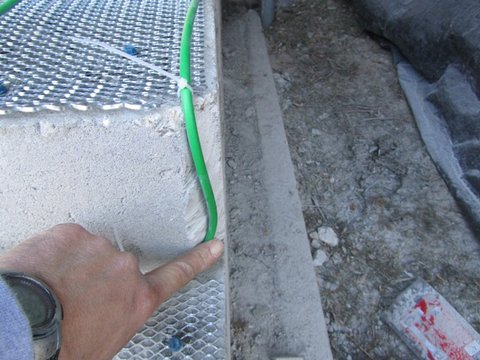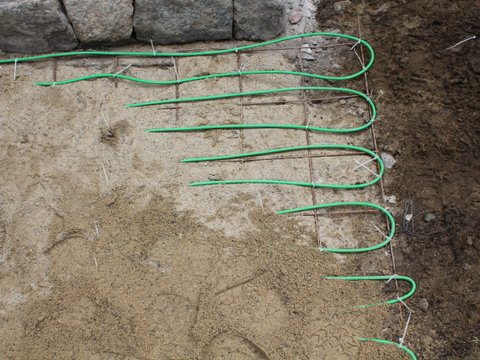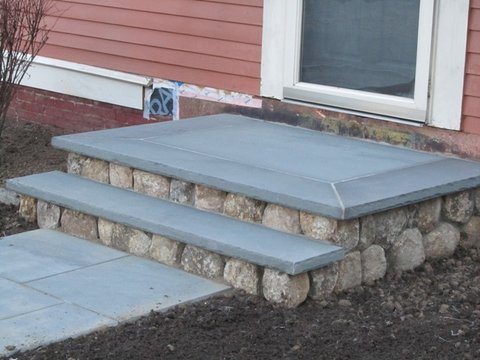Deicing Systems for Outdoor Stairs

Snow and ice can make outdoor stairs dangerous in the wintertime. Learn how installing a snow melting anti‑ice system can help keep you and your loved ones safe.
Our electric snow melting systems install in concrete, asphalt, or in mortar beneath pavers. When paired with an automatic control, the system can detect snow and clear your steps without shovels or chemicals.
Choose full‑coverage for every tread and landing, or focus heat on the primary steps and entryway to balance comfort, safety, and budget.
Why Heat Your Outdoor Stairs?
What is Snow Melting?
Have you ever seen snow fall on an already warm car? It melts instantly. This is the essential idea behind snow melting systems—a heating element is embedded in your stair treads, walkway, or ramp and it melts the snow that falls on it and prevents ice accumulation.
Like any outdoor surface, stairs can benefit from installing an electrically heated WarmlyYours snow melting system (available in both mats and cables).
Designed to install directly in concrete, asphalt, or in mortar beneath pavers, our systems ensure that your stairs shed ice and snow, allowing for safe passage.
Learn More About Snow MeltingFree SmartPlan
Get a custom installation plan for your outdoor stairs in just 1 business day.

"I'll design a custom snow melting layout for your project, complete with cable spacing, electrical requirements, and a full quote."
Key Concepts for Heated Outdoor Stairs
When incorporating a snow melting system into outdoor stairs, keep these key concepts in mind:
- Stair treads should be 11-12" from the front/nosing to the back/riser to ensure 4 passes of properly spaced heating cable in each tread.
- If your project includes stair-mounted handrails, subtract 3" from each side to allow room for handrail mountings.
- The heating element should be 2-3" from the final surface for optimal performance.
- Work with your WarmlyYours account manager to identify the best heating element for your project.
Installing the Snow Melting System
One of the great benefits of an electric radiant heating system is the thinness of the heating element (5/16" for mats and 1/4" for cables), meaning minimal impact on overall stair depth.
Follow these steps for a successful outdoor stairs installation:
Step 1. Laying Down a Rebar Frame or Wire Mesh
Attach heating cables with zip-ties or wire twists to a rebar frame or wire mesh to keep spacing consistent. The framework should be attached to a base layer 2-3" from the final surface.
Tip: Avoid using metal mesh with sharp edges or burrs.
Step 2. Preparation for Handrails
For stairs with handrails, install pre-sleeves for the posts to minimize drilling through the finished surface.
Route heating cable around sleeves or posts—never allow direct contact with metal fixtures.
Step 3. Start Laying Out the Heating Elements
Maintain proper spacing by attaching heating elements to the mesh using wire ties. This is a good time to dry fit your system.
Reference your free WarmlyYours SmartPlan to ensure everything lines up properly.
Step 4. Incorporating Cable into Risers
Route heating cable through risers between each tread. Cut channels in support blocks or saw-cut grooves in concrete.
The heating cable must always be embedded in concrete or mortar to prevent overheating.
Step 5. Installing Pavers
Cover the heating element with 1"–1.5" of mortar. Avoid dropping pavers into place, as this may damage the heating element.
Brick and stone pavers must not exceed 2.5" thickness.
The Finished Heated Stairs
Once completed, your stairs are ready for use. Just add snow! Monitor your system during the first few snowfalls to verify performance.
Systems continue running after snowfall ends to evaporate remaining water, leaving clean, dry surfaces.
Controls for Stairs Snow Melting
WarmlyYours offers a wide variety of controls—from manual options with timers to automatic controls that activate when they sense snow is falling.
Controls use two main types of sensors: slab sensors (installed with the heating element to measure surface conditions) and aerial sensors (installed in the open to detect snowfall). Note: slab sensors are not recommended for use with pavers.
For more information, check out this comparison chart.
Shop ControlsSnow Melting Products for Outdoor Stairs
For stairs, we typically recommend cables due to their flexibility in navigating treads and risers. Mats work well for landings.

Maximum Flexibility at a Minimal Cost
-
High Heat Output: This embeddable electric heating cable provides 12-watts of heat per linear foot (nearly 50-watts per sq. ft.)
-
Embeddable in Concrete, Asphalt, or in Mortar Under Pavers: Installing a cable-based snow melting system within a new driveway, walkway, or patio means you can enjoy snow/ice free outdoor surfaces all year
-
Cost-Effective and Flexible: Snow melting cables are an less expensive (but more time consuming) alternative to snow melting mats and they provide maximum flexibility to cover round driveways, cornered patios, or outdoor stairs
-
Wide Variety of Voltages: We offer snow melting cables in 120, 208, 240, and 277 voltages and in a range of different lengths
-
Installation Support: WarmlyYours offers free SmartPlan™ installation plans, 24/7 phone support, and a 10-year limited warranty

Maximum Heat Density for Heavy Snowfall (3" spacing)
-
Maximum Heat Output: Approximately 50-watts per sq. ft with 3" cable spacing for fastest snow melting
-
Best for Heavy Snowfall: Recommended for regions with 60+ inches of annual snowfall or when rapid melting is critical
-
Even Heating: Pre-attached heating elements in a serpentine pattern with consistent 3" spacing ensures uniform coverage
-
Fast and Easy Installation: Cut-and-turn design makes installation faster than cables while providing maximum heat density
-
Installation Support: Free SmartPlan™ installation plans, 24/7 phone support, and a 10-year limited warranty

Optimal Performance & Energy Balance (4" spacing)
-
Balanced Heat Output: Approximately 39-watts per sq. ft with 4" cable spacing for optimal performance and efficiency
-
Best for Moderate Snowfall: Recommended for regions with 30-60 inches of annual snowfall—our most popular choice
-
Even Heating: Pre-attached heating elements in a serpentine pattern with consistent 4" spacing ensures uniform coverage
-
Fast and Easy Installation: Cut-and-turn design makes installation faster than cables while balancing cost and performance
-
Installation Support: Free SmartPlan™ installation plans, 24/7 phone support, and a 10-year limited warranty


